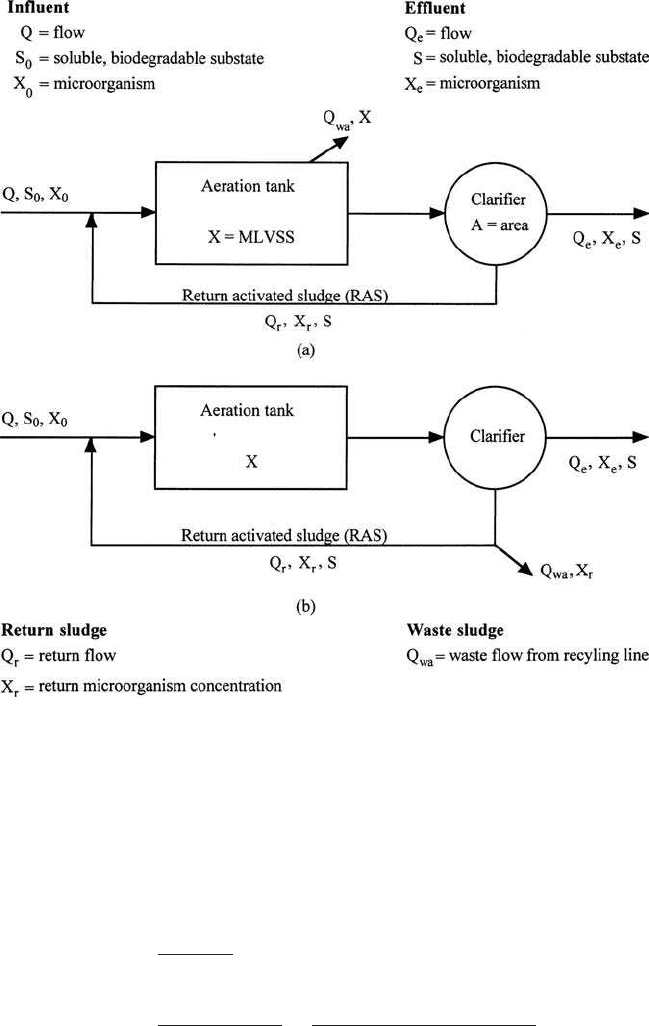Lin S.D. Water and Wastewater Calculations Manual
Подождите немного. Документ загружается.


BOD ⫽ Q ⫻ BOD ⫻ 8.34
⫽ 5.0 Mgal/d ⫻ 140 mg/L ⫻ 8.34 lb/gal
⫽ 5838 lb/d
Step 2. Calculate the volatile SS under aeration
Assume VSS is 80% of TSS
MLVSS ⫽ 35,500 lb ⫻ 0.8
⫽ 28,400 lb
Step 3. Calculate F/M ratio
Using Eq. (6.62)
F/M ⫽ (5838 lb/d)/(28,400 lb)
⫽ 0.206 lb BOD/d per lb MLVSS
Example 2: Convert the BOD concentration of 160 mg/L in the primary
effluent into BOD loading rate in terms of kg/m
3
and lb/1000 ft
3
. If this is used
for 24 h high rate aeration, what is the rate for 6 h aeration?
solution:
Step 1. Calculate BOD loading in kg/m
3
Step 2. Calculate BOD loading in lb/1000 ft
3
Thus
1 lb/1000 ft
3
5 0.016 kg/m
3
5 10 lb/1000 ft
3
5
0.01 lb 3 1000
1000 ft
3
5 0.01 lb/ft
3
0.16 kg/m
3
5
0.16 kg 3 2.205 lb/kg
1 m
3
3 35.3147 ft
3
/m
3
5 0.16 kg/m
3
5 160 g/m
3
160 mg/L 5
160 mg 3 s1 g/1000 mgd
1 L 3 s1 m
3
/1000 Ld
Wastewater Engineering 625

Step 3. Calculate loading for 6-h aeration
and
Note: Refer to Table 6.11 to meet Ten States Standards.
The influent BOD to the conventional activated-sludge process is limited to
160 mg/L for 6-h aeration.
21.3 Biochemical reactions
The mechanism of removal of biodegradable organic matter in aerobic
suspended-growth systems can be expressed by the energy production
or respiration equation
Organic matter ⫹ bacteria ⫹ O
2
→ CO
2
⫹ H
2
O ⫹ NH
⫹
4
⫹ new cells
(CHONS) (heterotrophic) (energy)
(6.66)
Further nitrification process can take place by selected autotrophs with
oxidation of ammonia to nitrate and protoplasm synthesis
Bacteria
NH
⫹
4
⫹ O
2
⫹ CO
2
⫹ HCO
3
NO
⫺
3
⫹ H
2
O ⫹ H
⫹
new cells (6.67)
Energy (protoplasm)
The oxidation of protoplasm is a metabolic reaction which breaks down
the protoplasm into elemental constituents, so that cells die. This is
called endogenous respiration or cell maintenance, as follows:
Protoplasm ⫹ O
2
CO
2
⫹ NH
3
⫹ H
2
O ⫹ dead cells (6.68)
21.4 Process design concepts
The activated-sludge process has been used extensively in its original
basic form as well as in many modified forms. The process design con-
siderations include hydraulic retention time (HRT) for reaction kinet-
ics; wastewater characteristics; environmental conditions, such as
temperature, pH, and alkalinity; and oxygen transfer.
Single or multiple aeration tanks are typically designed for completed
mixed flow, plug flow, or intermediate patterns and sized to provide an
HRT in the range of 0.5 to 24 h or more (WEF and ASCE, 1991a).
S
h
10.0 lb/d/1000 ft
3
3
24 h
6 h
5 40 lb/sd
#
m
3
d
0.16 kg/sd ? m
3
d 3
24 h
6 h
5 0.64 kg/sd
#
m
3
d
626 Chapter 6
In the past, designs of activated-sludge processes were generally
based on empirical parameters such as BOD
5
(simplified as BOD) load-
ings and aeration time (hydraulic retention time). In general, short
HRTs were used for weak wastewaters and long HRTs for strong
wastewaters. Nowadays, the basic theory and design parameters for the
activated-sludge process are well developed and generally accepted.
The different design approaches were proposed by researchers on the
basis of the concepts of BOD
5
, mass balance, and microbial growth kinet-
ics (McKinney, 1962; Eckenfelder, 1966; Jenkins and Garrison, 1968;
Eckenfelder and Ford, 1970; Lawrence and McCarty, 1970; Ramanathan
and Gaudy, 1971; Gaudy and Kincannon, 1977; Schroeder, 1977;
Bidstrup and Grady, 1988).
Solution of the theoretical sophisticated design equations and com-
puter models requires knowledge of microbial metabolism and growth
kinetics, with pilot studies to obtain design information. Alternatives
to such studies are: (1) to assume certain wastewater characteristics
and embark on a semiempirical design; and (2) to use an entirely empir-
ical approach relying on regulatory recommended standards (WEF and
ASCE, 1991a).
21.5 Process mathematical modeling
For almost half a century, numerous design criteria utilizing empirical
and rational parameters based on biological kinetic equations have been
developed for suspended-growth systems. A survey of major consulting
firms in the United States indicates that the basic Lawrence and
McCarty (1970) model is most widely used. Details of its development
can be obtained in the references (Lawrence and McCarty, 1970; Grady
and Lim, 1980; Qasim, 1985; Metcalf and Eddy, Inc. 1991). The basic
Lawrence and McCarty design equations used for sizing suspended-
growth systems are listed below.
Complete mix with recycle. The flow in a reactor is continuously stirred.
The contents of the reactor are mixed completely. It is called the
complete-mix reactor or continuous flow stirred tank reactor. Ideally, it
is uniform throughout the tank. If the mass input rate into the reactor
remains constant, the content of the effluent remains constant.
For a complete-mix system, the mean hydraulic retention time (HRT)
u for the aeration tank is
u ⫽ V/Q (6.69)
where u ⫽ hydraulic retention time, day
V ⫽ volume of aeration tank, m
3
Q ⫽ influent wastewater flow, m
3
/d
Wastewater Engineering 627

Referring to Fig. 6.15a, the mean cell residence time u
c
(or sludge age
or SRT) in the system is defined as the mass of organisms in the aeration
tank divided by the mass of organisms removed from the system per day,
and is expressed as
(6.70)
(6.71)
u
c
5
VX
Q
wa
X 1 Q
e
X
e
5
total mass SS in reactor
SS wasting rate
u
c
5
X
s⌬X/⌬td
628 Chapter 6
Figure 6.15 Schematic chart of complete-mix activated sludge reactor: (a) sludging wast-
ing from the aeration tank; (b) sludge wasting from return sludge line.

where u
c
⫽ mean cell residence time based on solids in the tank,
day
X ⫽ concentration of MLVSS maintained in the tank, mg/L
⌬X/⌬t ⫽ growth of biological sludge over time period ⌬t,
mg/(L ⭈ d)
Q
wa
⫽ flow of waste sludge removed from the aeration
tank, m
3
/d
Q
e
⫽ flow of treated effluent, m
3
/d
X
e
⫽ microorganism concentration (VSS) in effluent, mg/L
For system-drawn waste sludge from the return sludge line (Fig. 6.15b),
the mean cell residence time would be
(6.72)
where Q
wr
⫽ flow of waste sludge from return sludge line, m
3
/d
X
r
⫽ microorganism concentration in return sludge line, mg/L
Microorganism and substrate mass balance. Because the term V ⫻ MLSS
in Eq. (6.63) is a function of SRT or u
c
and not HRT or return sludge ratio,
the F/M ratio is also a function only of SRT. Therefore, operation of an
activated-sludge plant at constant SRT will result in operation at a con-
stant F/M ratio.
The mass balance for the microorganisms in the entire activated sludge
system is expressed as the rate of accumulation of the micro-organisms
in the inflow plus net growth, minus that in the outflow. Mathematically,
it is expressed as (Metcalf and Eddy, Inc. 1991)
(6.73)
where V ⫽ volume of aeration tank, m
3
dX/dt ⫽ rate of change of microorganisms concentration (VSS),
mg/(L ⭈ m
3
⭈ d)
Q ⫽ influent flow, m
3
/d
X
0
⫽ microorganisms concentration (VSS) in influent, mg/L
X ⫽ microorganisms concentration in tank, mg/L
r⬘
g
⫽ net rate of microorganism growth (VSS), mg/(L ⭈ d)
Other terms are as in the above equations.
The net rate of bacterial growth is expressed as
(6.74)rr
g
5 Yr
su
2 k
d
X
V
dX
dt
5 QX
0
1 Vsrr
g
d 2 sQ
wa
X 1 Q
e
X
e
d
u
c
5
VX
Q
wr
X
r
1 Q
e
X
e
Wastewater Engineering 629

where Y ⫽ maximum yield coefficient over finite period of log
growth, mg/mg
r
su
⫽ substrate utilization rate, mg/(m
3
⭈ d)
k
d
⫽ endogenous decay coefficient, per day
Substituting Eq. (6.74) into Eq. (6.73), and assuming the cell con-
centration in the influent is zero and steady-state conditions, this
yields
(6.75)
The left-hand side of Eq. (6.75) is the inverse of the mean cell residence
time u
c
as defined in Eq. (6.71); thus
(6.76)
The term 1/u
c
is the net specific growth rate.
The term r
su
can be computed from the following equation
(6.77)
where S
0
⫺ S ⫽ mass concentration of substrate utilized, mg/L
S
0
⫽ substrate concentration in influent, mg/L
S ⫽ substrate concentration in effluent, mg/L
u ⫽ hydraulic retention time (Eq. (6.69)), day
Effluent microorganism and substrate concentrations. The mass con-
centration of microorganisms X in the aeration tank can be derived by
substituting Eq. (6.77) into Eq. (6.76)
(6.78)
where m
m
⫽ maximum specific growth rate, per day
k ⫽ maximum rate of substrate utilization per unit mass of
microorganism, per day
Substituting for u from Eq. (6.69) for (6.78) and solving for the reactor
(aeration tank) volume yields
(6.79)
V 5
u
c
QYsS
0
2 Sd
Xs1 1 k
d
u
c
d
X 5
u
c
YsS
0
2 Sd
us1 1 k
d
u
c
d
5
m
m
sS
0
2 Sd
ks1 2 k
d
u
c
d
r
su
5
Q
V
sS
0
2 Sd 5
S
0
2 S
u
1
u
c
52Y
r
su
X
2 k
d
Q
wa
X 1 Q
e
X
e
VX
52Y
r
su
X
2 k
d
630 Chapter 6

The substrate concentration in effluent S can also be determined from
the substrate mass balance by the following equation
(6.80)
where S ⫽ effluent substrate (soluble BOD
5
) concentration, mg/L
K
s
⫽ half-velocity constant, substrate concentration at one
half the maximum growth rate, mg/L
Other terms are as mentioned in previous equations.
The ranges of typical biological kinetic coefficients for activated-sludge
systems for domestic wastewater are given in Table 6.12. When the
kinetic coefficients are available, Eqs. (6.78) and (6.80) can be used to
predict densities of effluent microorganisms and substrate (soluble
BOD
5
) concentrations, respectively. They do not take into account influ-
ent suspended solids concentrations (primary effluent). They can be
used to evaluate the effectiveness of various treatment system changes.
Substituting the value of X given by Eq. (6.78) for r⬘
g
in Eq. (6.74), and
dividing by the term S
0
⫺ S which corresponds to the value of r
su
expressed as concentration value, the observed yield in the system with
recycle is
(6.81)
whereY
obs
⫽ observed yield in the system with recycle, mg/mg
u
ct
⫽ mean of all residence times based on solids in the
aeration tank and in the secondary clarifier, day
Other terms are defined previously.
Process design and control relationships. To predict the effluent bio-
mass and BOD
5
concentration, the use of Eqs. (6.78) and (6.80) is difficult
Y
obs
5
Y
1 1 K
d
u
c
or u
ct
S 5
K
s
s1 1 u
c
k
d
d
u
c
sYk 2 k
d
d 2 1
Wastewater Engineering 631
TABLE 6.12 Ranges and Typical Biological Kinetic Coefficients
for the Activated-Sludge Process for Domestic Wastewater
Coefficient Range Typical value
k, per day 11–20 5
k
d
, per day 0.025–0.075 0.06
K
s
, mg/L BOD
5
25–100 60
mg/L COD 15–70 40
Y, mg VSS/mg BOD
5
0.4–0.8 0.6
SOURCE: Metcalf and Eddy, Inc. (1991), Techobanoglous and Schroeder
(1985)

because many coefficients have to be known. In practice, the relation-
ship between specific substrate utilization rate, mean cell residence
time, and the food to microorganism (F/M) ratio is commonly used for
activated-sludge process design and process control.
In Eq. (6.76), the term (⫺r
su
/X) is called the specific substrate utiliza-
tion rate (or food to microorganisms ratio), U. Applying r
su
in Eq. (6.77),
the specific substrate utilization rate can be computed by
(6.82)
(6.83)
The term U is substituted for the term (–r
su
/X) in Eq. (6.76). The result-
ing equation becomes
(6.84)
The term 1/u
c
is the net specific growth rate and is directly related
to U, the specific substrate utilization rate.
In order to determine the specific substrate utilization rate, the sub-
strate utilized and the biomass effective in the utilization must be given.
The substrate utilized can be computed from the difference between
the influent and the effluent BOD
5
or COD.
In the complete-mix activated-sludge process with recycle, waste
sludge (cells) can be withdrawn from the tank or from the recycling
line. If waste sludge is withdrawn from the tank and the VSS in the
effluent X
e
is negligible (Q
e
X
e
⬇ 0), Eq. (6.71) will (if X
e
is very small)
be approximately rewritten as
(6.85)
or
(6.86)
The flow rate of waste sludge from the sludge return line will be
approximately
(6.87)
where X
r
is the concentration (in mg/L) of sludge in the sludge return line.
Q
wr
5
VX
u
c
X
r
Q
wa
<
V
u
c
u
c
<
VX
Q
wa
X
1
u
c
5 YU 2 k
d
U 5
QsS
0
2 Sd
VX
5
S
0
2 S
uX
U 5 2
r
su
X
632 Chapter 6

In practice, the food-to-microorganism (F/M) ratio is widely used and
is closely related to the specific substrate utilization rate U. The F/M
(in per day) ratio is defined as the influent soluble BOD
5
concentration
(S
0
) divided by the product of hydraulic retention time u and MLVSS con-
centration X in the aeration tank
(6.88)
F/M and U are related by the efficiency E of the activated-sludge process
as follows:
(6.89)
The value of E is determined by
(6.90)
where E ⫽ process efficiency, %
S
o
⫽ influent substrate concentration, mg/L
S ⫽ effluent substrate concentration, mg/L
Sludge production. The amount of sludge generated (increased) per day
affects the design of the sludge treatment and disposal facilities. It can
be calculated by
(SI units) (6.91)
(British system) (6.92)
where P
x
⫽ net waste activated sludge (VSS), kg/d or lb/d
Y
obs
⫽ observed yield (Eq. (6.81)), g/g or lb/lb
Q ⫽ influent wastewater flow, m
3
/d or Mgal/d
S
0
⫽ influent soluble BOD
5
concentration, mg/L
S ⫽ effluent soluble BOD
5
concentration, mg/L
8.34 ⫽ conversion factor, lb/(Mgal) ⭈ (mg/L)
Oxygen requirements in the process. The theoretical oxygen require-
ment in the activated sludge is determined from BOD
5
of the waste-
water and the amount of microorganisms wasted per day from the
P
x
5 Y
obs
QsS
0
2 Sd s8.34d
P
x
5 Y
obs
QsS
0
2 Sd 4 s1000 g/kgd
E 5
S
0
2 S
S
0
3 100
U 5
sF/MdE
100
F/M 5
S
0
uX
5
QS
0
VX
5
mg BOD
5
/d
mg MLVSS
Wastewater Engineering 633

process. The biochemical reaction can be expressed as below
organism cells (6.93)
1 1.42
Equation (6.93) suggests that the BOD
u
(ultimate BOD) for one mole
of cells requires 1.42 (160/113) moles of oxygen. Thus the theoretical
oxygen requirement to remove the carbonaceous organic matter in
wastewater for an activated-sludge process is expressed as (Metcalf
and Eddy, Inc. 1991).
Mass of O
2
/d ⫽ total mass of BOD
u
used ⫺ 1.42
(mass of organisms wasted, p
x
)
(SI units) (6.94a)
(6.94b)
(US customary units)
(6.95)
where Q ⫽ influent flow, m
3
/d or Mgal/d
S
0
⫽ influent soluble BOD
5
concentration, mg/L
S ⫽ effluent soluble BOD
5
concentration, mg/L
f ⫽ conversion factor for converting BOD
5
to BOD
u
Y
obs
⫽ observed yield, g/g or lb/lb
8.34 ⫽ conversion factor, lb/(Mgal ⭈ (mg/L))
When nitrification is considered, the total oxygen requirement is the
mass of oxygen per day for removal of carbonaceous matter and for
nitrification. It can be calculated as
(SI units) (6.96)
(US customary units) (6.97)
where N
0
⫽ influent total kjeldahl nitrogen concentration, mg/L
N ⫽ effluent total kjeldahl nitrogen concentration, mg/L
4.75 ⫽ conversion factor for oxygen requirement for complete
oxidation of TKN
1
4.75sN
0
2 Nd]
lb O
2
/d 5 8.34[QsS
0
2 Sds1/f 2 1.42Y
obs
d
kg O
2
/d 5
QsS
0
2 Sd
1000 g/kg
a
1
f
2 1.42 Y
obs
b 1
QsN
0
2 N d
1000 g/kg
lb O
2
/d 5 QsS
0
2 Sd 3 8.34a
1
f
2 1.42Y
obs
b
kg O
2
/d 5
QsS
0
2 Sd
1000 g/kg
a
1
f
2 1.42Y
obs
b
kg O
2
/d 5
QsS
0
2 Sd
s1000 g/kgd f
2 1.42P
x
C
5
H
7
NO
2
113
1
5O
2
5 3 32 5 160
S
5CO
2
1 2H
2
O 1 NH
3
1 energy
634 Chapter 6
